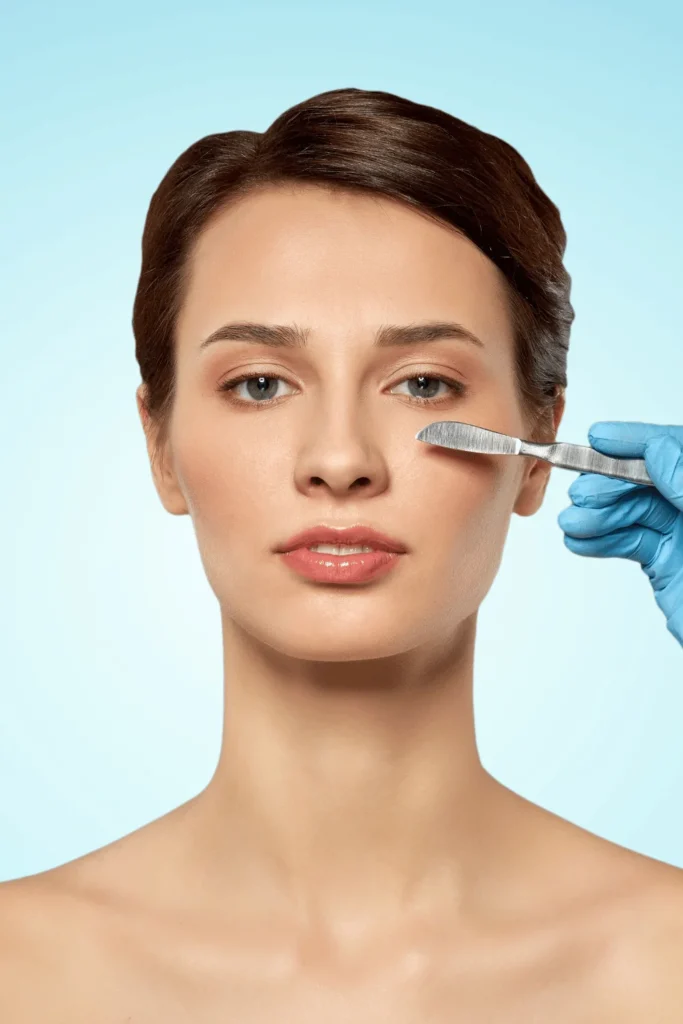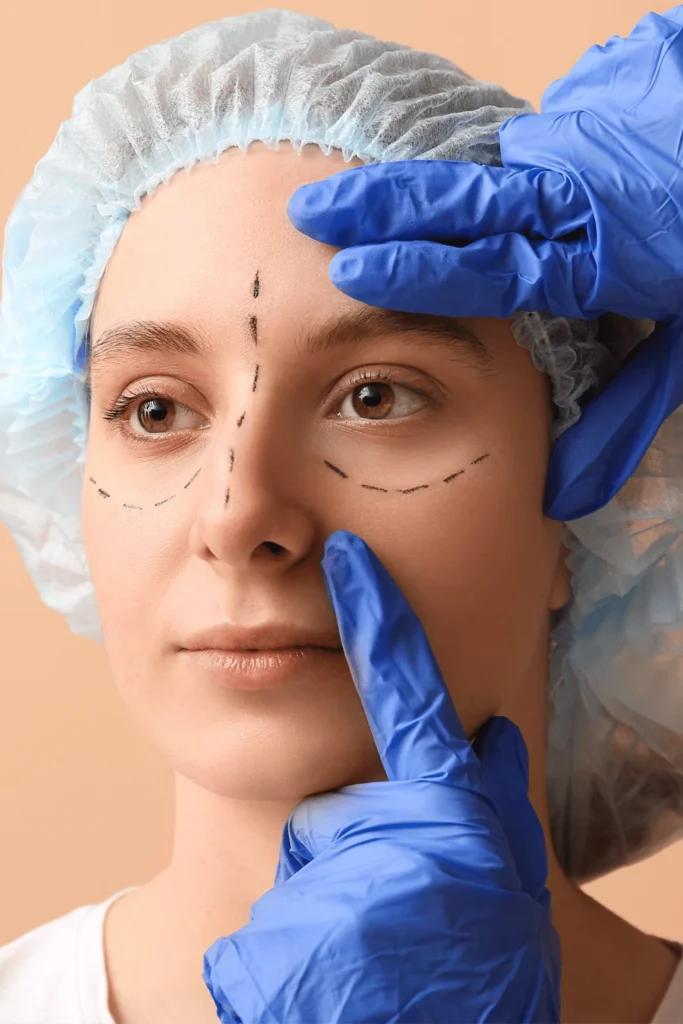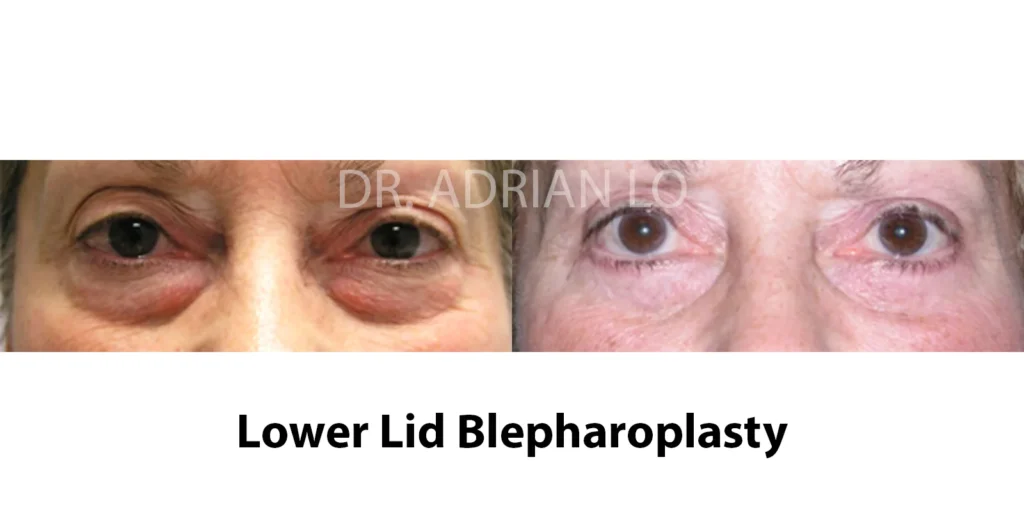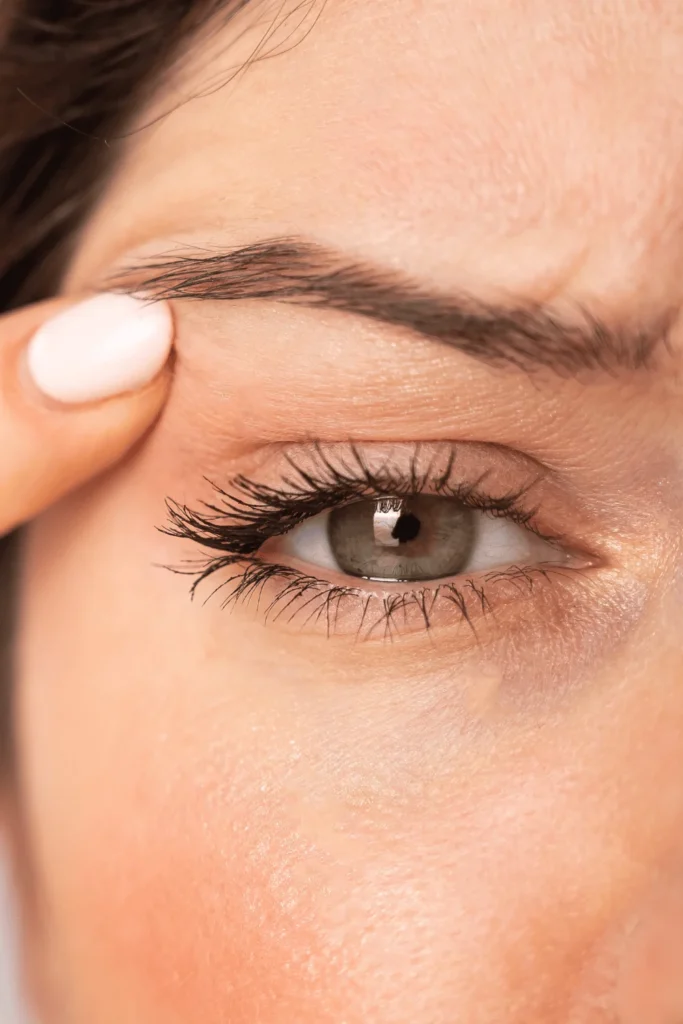As we go through life, our lower eyelids can become a telltale sign of aging.
Bags under the eyes, dark circles, and sagging skin not only affect our appearance but also our self-esteem.
With the right knowledge, we can set realistic expectations for your eyelid surgery so you’re empowered with all the information you need to understand the surgery process!
Let’s walk through lower blepharoplasty before and after comparisons, tips and questions to ask so that you are prepared for your consultation at our New Jersey or Philadelphia plastic surgery offices!
What is Lower Blepharoplasty?

Lower blepharoplasty is a surgical procedure designed to enhance the appearance of the lower eyelids. Unlike other eyelid surgeries, such as upper eyelid blepharoplasty, which focuses on the upper lids, lower blepharoplasty specifically targets the under-eye area.
The surgical goal is clear: to effectively remove excess skin and fat from the lower eyelids, ultimately resulting in a smoother, more youthful appearance.
Candidates & Reasons for Lower Blepharoplasty
Visible Signs of Aging
As we age, our skin loses elasticity, and the fat that once provided youthful contours can begin to protrude causing bags underneath the eyes. Individuals look tired or older than their actual age with visible signs of aging around the eyes such as:
- Bags under the eyes
- Dark circles
- Sagging skin
Many people consider lower eyelid blepharoplasty as a means to refresh their look. It’s essential, however, to reflect on how these visible signs impact not only appearance but also emotional well-being. After all, when we feel confident in our appearance, it can positively influence various aspects of our lives.
Functional Issues
Having functional issues with lower eyelids is not common. Usually the aging in the lower eyelid is cosmetic in nature. However, at times, saggy lower eyelids may lead to functional problems, such as dry eyes, and this may need to be corrected at the same time as a lower eyelid blepharoplasty.
Age-Related Considerations
While there’s no specific age limit, the typical candidates for lower blepharoplasty are usually in their 40s to 60s. At this stage, many individuals notice changing fat distribution and skin elasticity in the lower eyelids. There are also many patients in their 20s that have fat bags that are genetic in nature and are also good candidates for lower eyelid surgery.
Age can bring wisdom, but age alone is not the sole determinant of what is the right time for such enhancements. Reflecting on how you feel about your appearance now can help you guide this decision.
Health Requirements
Before considering surgery, a few health prerequisites should be met. It’s essential to undergo thorough health evaluations, which may include eye exams and an assessment of your medical history.
Discussing existing health conditions that might affect surgery outcomes is crucial. Additionally, making lifestyle changes where necessary can lead to improved surgical results. For instance, quitting smoking is important to optimize healing and outcomes.
The Lower Blepharoplasty Procedure

Preparation
Preparation begins well before the surgery date. Patients should schedule consultations with a qualified plastic surgeon to discuss their expectations and to answer any questions or concerns that you may have. This conversation should include the desired outcomes and what to realistically expect.
Your plastic surgeon may recommend specific medical evaluations and guidelines that you should follow. For instance, avoiding anti-inflammatory medications such as aspirin and ibuprofen and blood thinners 2 weeks before and 1 week after the procedure helps reduce bleeding. Proper preparation is key to a successful surgery. This will all be discussed during your consultation and pre-operative appointments.
Surgery
The surgery itself typically lasts about 45 minutes to 1 hour and can be performed under local anesthesia or sedation or general anesthesia, depending on your needs and preferences. The surgical techniques employed can vary.
Some patients will be recommended for the transconjunctival approach, which involves making incisions inside the eyelid. This method is ideal for patients needing fat removal without additional skin excision. On the other hand, the traditional external approach, subciliary incision involves an incision just below the lash line, allowing for skin tightening if necessary.
As the incisions are typically made beneath the lower eyelid lashes or inside the eyelid, potential scarring is usually minimal and often unnoticeable once healed.
Knowing what to expect during surgery can significantly reduce anxiety, making for a smoother experience.
Recovery
Lower eyelid surgery recovery typically spans 1-2 weeks, with the healing process varying from patient to patient based on individual factors and adherence to post-operative care instructions.
Swelling and bruising are common, typically peaking in the first few days and gradually subsiding after a week or two. Using cold compresses and following pain management protocols recommended by your plastic surgeon can ease discomfort. Lower eyelid blepharoplasty surgery is not usually a painful procedure and is well tolerated. Often over the counter pain relief medications are usually all that is required.
Be vigilant in following aftercare instructions to promote optimal healing and results. The importance of patience and self-care during this recovery period cannot be overstated!
Lower Blepharoplasty: Before-and-After Results
Examining lower blepharoplasty before and after results is perhaps one of the most exciting portions of the journey, as it allows patients to witness the possible transformation firsthand. Our collection of blepharoplasty before and after photos serves as a powerful visual testament to the transformative effects that can be achieved through this specialized cosmetic eyelid surgery.

Eyelid surgery results often lead to patients reporting increased confidence and a rejuvenated appearance, with outcomes that can significantly reduce visible signs of aging.
When evaluating lower eyelid blepharoplasty before and after outcomes, it’s crucial to understand that results can vary due to individual factors such as genetics, skin type, and overall health.
Many previous patients have shared their experiences of rejuvenation through blepharoplasty, expressing gratitude for the renewed sense of self and youthful appearance they gained through the surgical process.
Lower Blepharoplasty: FAQs

How long does a lower eyelid blepharoplasty procedure typically take?
A lower blepharoplasty surgery usually takes about 45 min to 1 hour to complete, depending on the extent of the work needed and the surgical technique used.
Is lower eyelid blepharoplasty painful?
Most patients experience minimal discomfort during recovery. Pain can be managed with ice, over the counter pain relief medication and typically subsides within a few days after surgery.
How long is the recovery period for lower blepharoplasty?
While individual experiences may vary, most patients can return to normal activities within 7-14 days. Complete healing may take several weeks to a few months.
Will there be visible scars after lower blepharoplasty?
Incisions are typically made beneath the lower eyelid lashes or inside the eyelid, making any potential scarring minimal and often unnoticeable once healed.
Can lower blepharoplasty be combined with other procedures?
Yes! Lower eyelid blepharoplasty can often be combined with other facial procedures such as upper eyelid blepharoplasty, facelift, or brow lift for a more comprehensive rejuvenation.
How long do the results of lower blepharoplasty last?
While no cosmetic procedure lasts forever, the results of lower lid blepharoplasty are typically long-lasting. Many patients enjoy their results for 10-15 years or more.
Are there any non-surgical alternatives to lower blepharoplasty?
While non-surgical treatments like dermal fillers or laser treatments can provide some improvement, they cannot achieve the same dramatic results as surgery for significant under-eye bags or excess skin.
What are the potential risks or complications of lower blepharoplasty?
It’s important for patients to be aware of lower blepharoplasty risks, which may include infection, bleeding, adverse reactions to anesthesia, and other potential complications specific to eyelid surgery.
Specific to this procedure, risks may include dry eyes, temporary changes in vision, or asymmetry. However, these risks are minimized when the procedure is performed by a board-certified plastic surgeon.
Contact Dr. Adrian Lo For Stunning Lower Blepharoplasty Before-And-After Results
With extensive experience and training, Dr. Lo’s approach is both individualized and patient-centered. Dr. Lo understands that each patient has unique needs and desires, which is why he focuses on developing individualized surgical treatment plans.
If you’re excited to start your lower eyelid surgery in Philadelphia, the next step is right in front of you! Contact us today to schedule your consultation and take the first step towards rejuvenation.
